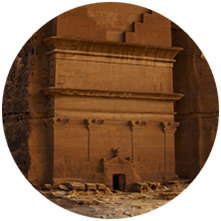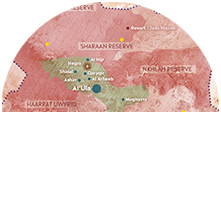LUSH
BUT DEGRADED
BIODIVERSITY
0








LUSH
BUT DEGRADED
BIODIVERSITY






Focus
Focus




















BACK TO HOMEPAGE
TOP
NEXT
- Share -









With annual precipitation accounting for less than 50mm, the desert of AlUla is among the world's most notable hyper-arid hot deserts. Despite the extreme environmental conditions, it is home to remarkable biodiversity, consisting of a mosaic of habitats - wadis*, canyons, mountains, sand dunes, ravines and volcanic plateaus - and a great diversity of flora and fauna.
Deserts are fragile environments with a long history of human exploitation, that intensified recently, as a result of the kingdom's "oil revolution". Overgrazing, the sedentarization of Bedouin populations, the overexploitation of groundwater and the rapid expansion of agriculture have placed growing pressure on these limited natural resources.
At present, the desert of AlUla is mostly degraded. Its vegetation cover and wildlife have declined, its soils are degraded and its aquifers are being depleted. However, the natural heritage of AlUla is as precious as its culture and history. As part of the region's sustainable development, preserving and restoring this natural environment has become an increasing priority.

LUSH BUT DEGRADED BIODIVERSITY
In AlUla, restoring ecosystems degraded mostly by overgrazing is key to re-establish vegetation cover, and progressively reintroducing herbivores with the ultimate objective being the reintroduction of the Arabian leopard, a flagship species of the kingdom, back to its native range in AlUla.
The ecological restoration program carried out in AlUla is part of the three strategic pillars of the Wildlife & Natural Heritage department of the Royal Commission for AlUla (RCU).
* Wadi means “valley” in Arabic.
It refers to a dry river bed, except after sudden floods or rains, which happen from time to time in the deserts of Arabia.
“Despite its extreme environmental conditions, the AlUla desert is home
to a remarkable biodiversity”


FIND OUT MORE


ACACIA:
A STRUCTURING SPECIES


NURSE PLANTS
AS FACILITATORS
Ecological restoration assists a degraded, damaged or destroyed ecosystem in recovering. It consists essentially of two approaches, depending on the degree of ecosytem degradation.
Passive restoration allows an ecosystem to recover naturally by stopping the factors causing damage, while active restoration involves restoring a degraded ecosystem through direct human intervention, such as planting.

ECOLOGICAL RESTORATION:
ONE PROJECT,
TWO METHODS
FIND OUT MORE


AlUla:
the challenge
of ecological restoration



The success of ecological restoration also depends on the active engagement of the local communities and the sustainable socio-economic development of the county. The development of ecotourism represents a real opportunity to reconcile humans and nature across the northwest of the kingdom.
The National Park of Sharaan covers 1,543 km² of plains, dunes, red sandstone canyons and wadis.
The site was declared a “reserve” by a royal decree in 2019. It is also the central site for the ecological restoration program of the Royal Commission for AlUla.
The reserve was entirely fenced in 2020 to limit the anthropogenic pressures on its ecosystems such as overgrazing, off-roading, illegal logging, etc. thus, all the protected area has been undergoing passive restoration. This approach is proving effective, as vegetation cover continues to expand and flourish.
To address the absence of reference ecosystems (i.e. undisturbed), the RCU established a pilot site of 100 ha to test different scenarios of active ecological restoration of native plant associations and different irrigation methods in line with international guidelines and best practices.
At the Majaz site, covering 5,000 ha, 500,000 native trees and shrubs were planted between 2022 and 2024. Experts are testing various techniques there.

SHARAAN PILOT SITE

FIND OUT MORE


FERTILITY
ISLANDS

















VISIT AFALULA.COM
READ THE PREVIOUS ISSUES
Subscribe to the newsletter























